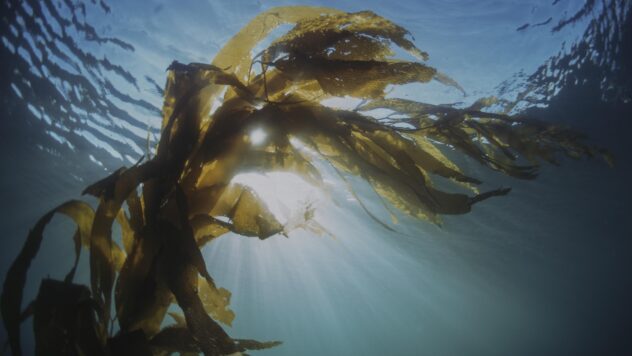Species
Alaska Seaweed InsightsFarmed species in Alaska
Alaska is home to a vast collection of kelp species. Kelps are large brown algae that make up the order of Laminariales. Farmers in Alaska are experimenting with different kelp species for farming. These species have different properties, taste profiles, and farming methods.
Sugar Kelp
Saccharina latissimaThe color of this very common kelp is light to medium brown with a finely branched holdfast (haptera), a cylindrical stipe up to 20 inches (50 cm) long, and a blade up to 10 feet (3.5 meters) long. The blade is moderately thin and moves in the water, frequently with rows of blister-like swellings near the base.
Habitat
Although this kelp is considered a perennial (means plants that live more than 2 years), the blade dies in the fall/winter and re-grows in the spring. Its holdfast attaches to rock in the low intertidal to subtidal and prefers protected to semi-protected habitats.
Edible uses
Sugar kelp is closely related to Saccharina japonica, the famous and most commonly farmed kelp in East Asia, where it is a staple food often served with fish and meat dishes or as base for broths (dashi) and soups.
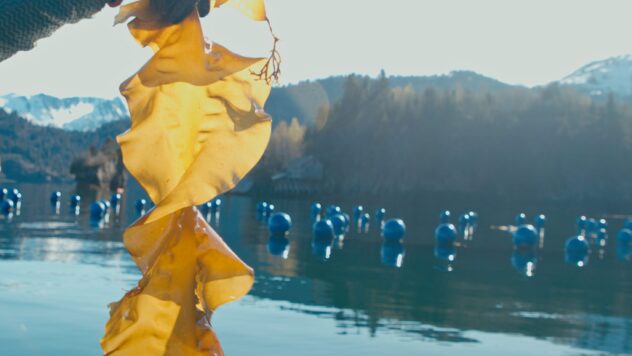
Bull Kelp
Nereocystis luetkeanaThis common canopy-forming kelp has a richly branched holdfast (haptera) and a cylindrical stipe 33–118 feet (10–36 meters) long, terminating in a single, gas-filled bladder from which the many blades, up to 33 feet (10 meters) long, develop. The blades growth can reach 6 inches (15 centimeters) per day. Reproductive patches (sori) develop on the blades and drop to the seafloor at maturity. Bull kelp is notably one of the fastest growing seaweed in the world. It can grow from a tiny spore into a 200-feet-long plant in one season.
Habitat
This annual kelp grows on rock from the low intertidal to subtidal; it prefers semi-exposed habitats or high current areas. Offshore beds can persist for one to many years, usually in deeper water than Eualaria or Macrocystis, where they co-occur.
Edible uses
Food products, including salsas and pickles. Kelp extract (alginate) is used to thicken products such as ice cream, salad dressing, hand lotion and paint. It is also utilised as an additive to organic seafood-based fertilizers.
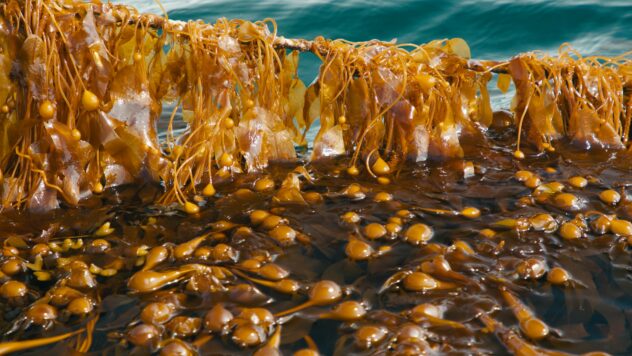
Dragon Kelp
Eualaria fistulosaDragon Kelp, or Eualaria fistulosa, is characterized by long, cylindrical stipes extending up to 131 feet (40 meters), supporting large, fan-shaped blades. The holdfast is richly branched, securing the kelp to rocky substrates. The blades, which can grow up to 33 feet (10 meters), are typically smooth and robust, making this species well-suited to high-energy environments.
Habitat
This perennial kelp thrives in subtidal zones, preferring semi-exposed to exposed habitats with strong currents. Dragon Kelp is commonly attached to rocks in deeper waters, often forming dense underwater forests. Its ability to withstand intense wave action and currents makes it a dominant species in its preferred habitats.
Edible uses
Dragon Kelp is highly valued in culinary applications for its umami-rich flavor. It can be dried and powdered, serving as a nutritious additive in various food items, such as broths, soups, and sauces. The kelp’s high alginate content also makes it useful as a thickening agent in foods like dressings and desserts.
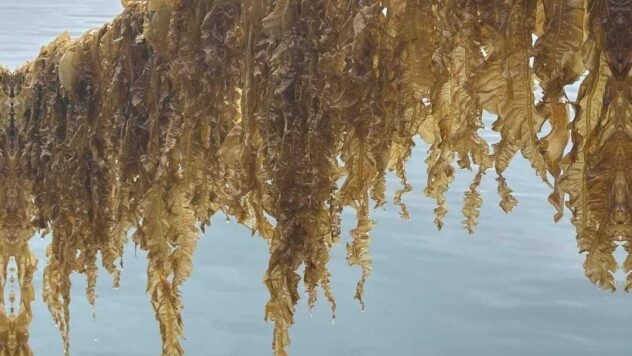
Ribbon Kelp
Alaria marginataThe color of this intertidal kelp is brown with a branched holdfast (haptera), a stipe, cylindrical near the base but flattened near the blade, that can reach 12 inches (30 centimeters) or more in length, and a thin blade up to 10 feet (3 meters) long. Twenty to forty spore bearing blades form in spring on the upper portion of the stipe and grow up to 10 inches (25 centimeters) long, thickening with maturity.
Habitat
This kelp is an annual plant that thrives on rocks in the mid to low intertidal areas, ranging from semi-protected to exposed habitats, as long as there is sufficient current.
Edible uses
Miso soups, powdered additives to food products, as an emulsifier, and condiment.
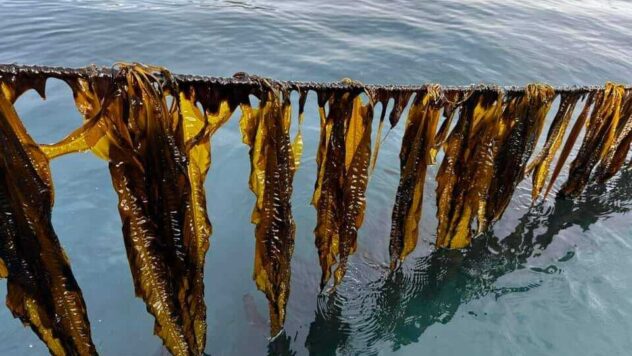
Split Kelp
Saccharina groenlandicaSplit Kelp, or Saccharina groenlandica, is a perennial brown seaweed with a single blade that can grow up to 6.5 feet (2 meters) in length, attached to a stipe up to 2 feet (60 centimeters) long. The blade often splits once or twice along its length. The stipe is flattened at the base, leading to a small but highly branched holdfast. Split Kelp typically ranges from dark to medium brown.
Habitat
This kelp attaches to rocks in low intertidal and shallow subtidal zones, thriving in semi-exposed to semi-protected locations. It is found from the Bering Sea and the Aleutian Islands to central California and westward to Kamchatka and the Kurile Islands in Russia.
Edible uses
Split Kelp is valued for its umami flavor and nutritional content. It can be dried and powdered as a seasoning or added to soups and stews. Its thick texture also makes it suitable as an emulsifier in food products and as an additive in organic fertilizers.
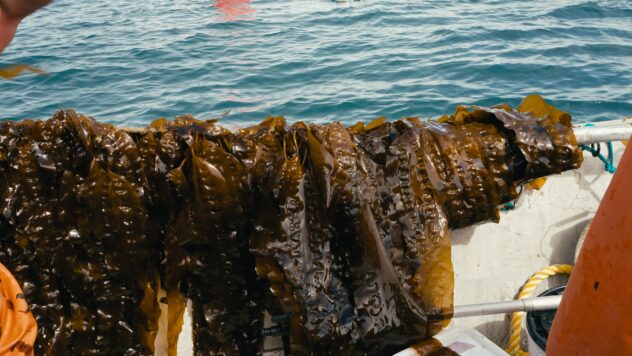
Giant Kelp
MacrocystisGiant Kelp, or Macrocystis pyrifera, is a large brown algae that forms dense underwater forests. It can grow over 150 feet (45 meters) long, with multiple branching blades that arise from a long, flexible stipe. Each blade is buoyed by gas-filled structures called pneumatocysts. The holdfast, a root-like structure, anchors the kelp to rocky substrates. Giant Kelp can grow incredibly fast, sometimes up to 2 feet (60 centimeters) per day, making it one of the fastest-growing organisms on Earth.
Habitat
Giant Kelp thrives in nutrient-rich, cold waters, primarily along the Pacific coasts of North and South America. It inhabits depths from 6 to 90 feet (2 to 30 meters), attaching to rocky bottoms in areas with strong water movement, which ensures a steady flow of nutrients. Kelp forests provide vital habitats for many marine species and act as underwater nurseries.
Edible uses
Giant Kelp is rich in vitamins and minerals, particularly iodine and potassium. It is harvested for its use as a thickener and stabilizer in food products like ice cream and sauces. It is also used in dietary supplements, cosmetics, and organic fertilizers due to its high nutrient content.
